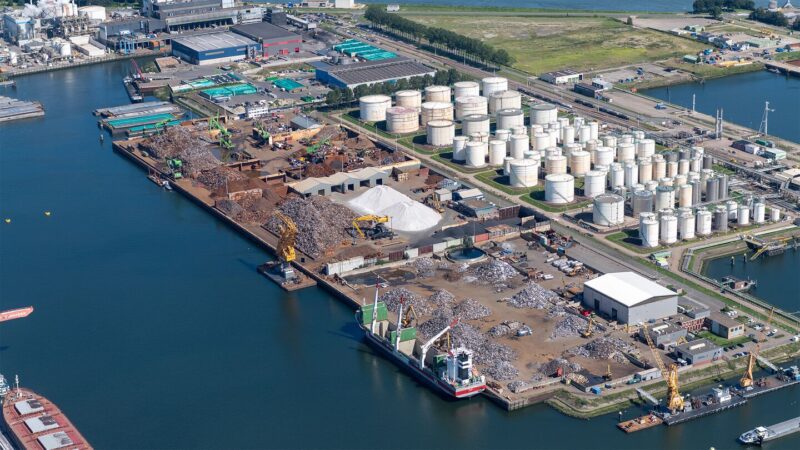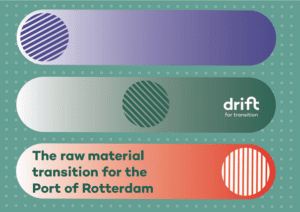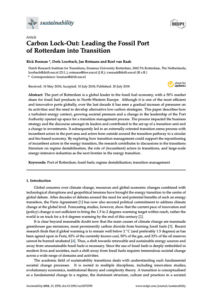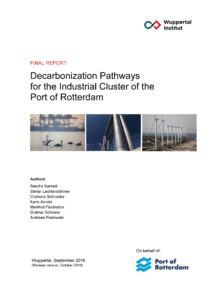DRIFT research offers the Port of Rotterdam guidelines for the raw material transition
Will Europe continue to have access to enough raw materials for the green technology needed for the energy transition? Different product processes, non-fossil raw materials and rare materials are crucial for a CO2-neutral, circular society. What role can the port of Rotterdam play in the raw material transition and which choices have to be made to achieve that? Those are the central questions in recent DRIFT research, commissioned by the Port of Rotterdam Authority. The result of this collaboration is The raw material transition for the Port of Rotterdam report.
The challenge for Rotterdam
The Port of Rotterdam is facing the challenge of transforming from a fossil petrochemical cluster that focuses on refining to a new energy and chemistry port. As Europe’s largest port, this challenge is a tremendous one, as the port area was responsible for 22.5 megatonnes of CO₂ emissions in 2022. The Port has committed to reducing its emissions by as much as 55% by 2030 and to being carbon-neutral by 2050. Innovations such as carbon capture and storage and low-carbon hydrogen as well as saving energy will be key to achieving this.
However, this energy transition cannot happen without raw materials. The success of the energy transition hinges on the availability and accessibility of raw materials sourced from a limited number of countries
The challenge and opportunity for the Port of Rotterdam is to position itself at different scales – from the local level to the north-west European and global levels – in relation to the (raw) material transition.
Source: DRIFT
No energy transition can occur in isolation
The main focus of the energy transition is to reduce greenhouse gases. However, other challenges related to exceeding our planetary and social boundaries, such as biodiversity loss and the threat to the health of our living environment, require more and different action. These societal problems are connected to energy transition and affect a wider system: they relate not only to the extraction, production and consumption of energy, but also to the extraction, production and consumption of (raw) materials.
Six developments have put pressure on the availability or usage of these raw material flows and show both the urgency and the interconnectedness of this transition: increased demand, limited supply of materials, limited recycling capacity, decarbonisation goals, geopolitical dependency and sensitivity, limited availability of land and labour.
Moreover, the EU aims to recycle at least 25% and process 40% of its annual consumption. However, these goals are not only rather limited but also voluntary and have not yet been translated into action.
The report advocates a radical change in the import flows and industry in the port. The raw material transition is a precondition for the success of the energy transition worldwide and for the future of the port of Rotterdam. At the same time, it forms the precursor to a circular economy that is now very much in development, but which is essential if the earth’s resources are not to be further exhausted. Not only that, but making and recycling products contributes in this context to Europe’s strategic autonomy. One conclusion of the research is that the circular economy needs more physical space for the collection and separation of all residual and waste flows for processing into new products. According to the research, this means that it is necessary to look beyond the current port area.
Prof. Jan Rotmans MA MSc., founder of DRIFT: ‘The raw material transition is crucial to the energy transition, for the world, for Europe, for the Netherlands and for the port of Rotterdam. As yet, the circular economy forms only 7% of the real economy worldwide. If the port of Rotterdam wants to become circular, more space is needed for the processing of all the residual and waste flows. That will mean judicious decision-making for the future.’
Boudewijn Siemons, CEO of Port of Rotterdam Authority: ‘The energy transition is beginning to take shape and the next step is to consolidate the raw material transition. There are already very promising activities in recycling and the port of Rotterdam has the largest cluster of biofuels in Europe. At present, extra biorefineries are being built in Rotterdam that produce on the basis of organic materials and residual products. We need to further expand this and scale it up. For that reason, we are developing a raw material strategy this year, for which this research offers valuable guidelines.’
Import of raw materials
The research focuses on three major product chains: critical raw materials, chemicals and building materials. Critical raw materials are those currently often imported and used in small quantities in Europe but that are essential for all sorts of technologies. Multiple quantities are needed for the energy transition. The European Critical Raw Materials Act sets goals for 2030 for the percentage of raw materials that must come from Europe itself (10%), the processing capacity (40%) and recycling (15%). Many materials must be imported from other parts of the world which now mainly supply to other countries, in particular China. The report recommends that Rotterdam take a leading role in raw material diplomacy, aimed at bilateral collaboration. And it is important that more businesses which recycle and process those critical raw materials are established in or around the port.
New value chains
Scaling up industry which processes that waste (also plastic) into new products is essential. The raw materials in the chemicals industry are now often based on crude oil and other fossil sources. That has to change. It requires a fundamental change to the system and new value chains of other raw materials. Other advice in the report is to build a network and infrastructure in the current “hinterland” of North West Europe, to recover materials. That will mean new input, such as pyrolysis oil from used plastic.
From fossils to bio-based
Constructing with concrete and steel requires a lot of energy and leads to high emissions of CO2. Constructing with bio-based materials such as wood is a good alternative. Fundamental changes in the raw materials chain are needed, from countries of production to the processing industry. Rotterdam can play a role in the import of wood as a building material.
Setting up new value chains of raw and other materials requires making choices; which activities should scale up, which will disappear and what does all that mean for the existing value chains? How should the scarce space be distributed? This research gives guidelines for the raw materials strategy that the Port of Rotterdam Authority is in the process of developing. The strategy is scheduled to be completed this year.
This post DRIFT research offers the port of Rotterdam guidelines for the raw material transition | Port of Rotterdam first appeared on the Port of Rotterdam website on March 14, 2024.
Image credit: Martens Multimedia
The DRIFT report
In this report, the Dutch Research Institute for Transitions (DRIFT) explore strategies for the Port of Rotterdam to navigate the (raw) material transition. Section 2 discusses the transition challenge for each of the three material flows most heavily impacted by six developments. Section 3 presents several transition strategies that can be implemented to deal with the transition challenges. Section 4 provides an analysis of the five crossroads the Port of Rotterdam now finds itself at and strategies, actors and actions that will ensure that it moves successfully forward into the future.




